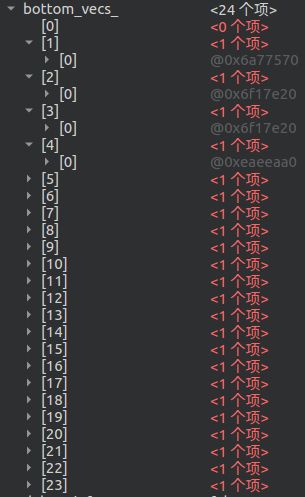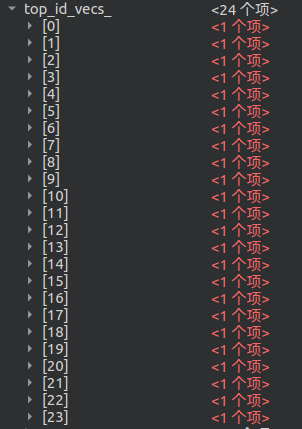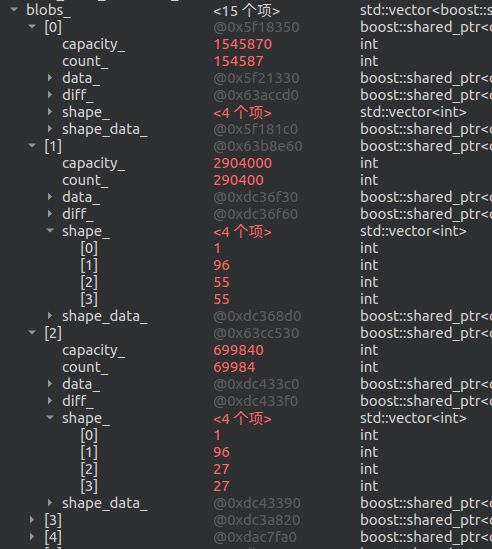- JVM内存优化的秘密武器:压缩指针详解
墨瑾轩
一起学学Java【一】jvmjava开发语言
关注墨瑾轩,带你探索编程的奥秘!超萌技术攻略,轻松晋级编程高手技术宝库已备好,就等你来挖掘订阅墨瑾轩,智趣学习不孤单即刻启航,编程之旅更有趣引言嘿,小伙伴们,我是你们的技术领航员zq啦!今天,咱们要一起探讨一个超棒的话题——JVM中的压缩指针技术。压缩指针就像是魔法中的缩小药水,能让原本庞大的指针变得小巧玲珑,从而节省宝贵的内存空间。别急,让我们慢慢揭开它的神秘面纱!正文一、刨根问底:压缩指针是什
- 【JVM】详解直接内存
起名方面没有灵感
JVMjvmjava开发语言
文章目录1.直接内存概述2.直接内存的使用2.1Java缓冲区2.2直接内存3.直接内存的释放3.1直接内存释放原理4.禁用显式回收对直接内存的影响1.直接内存概述下面是《深入理解Java虚拟机第三版》2.2.7小节关于Java直接内存的描述。直接内存(DirectMemory)并不是虚拟机运行时数据区的一部分,也不是《Java虚拟机规范》中定义的内存区域。但是这部分内存也被频繁地使用,而且也可能
- Linux下JVM相关指令详解及案例介绍
码农阿豪@新空间
好“物”分享linuxjvm运维
个人名片作者简介:java领域优质创作者个人主页:码农阿豪工作室:新空间代码工作室(提供各种软件服务)个人邮箱:[
[email protected]]个人微信:15279484656个人导航网站:www.forff.top座右铭:总有人要赢。为什么不能是我呢?专栏导航:码农阿豪系列专栏导航面试专栏:收集了java相关高频面试题,面试实战总结️Spring5系列专栏:整理了Spring5重要知识点与
- JVM 内存管理详解
pjx987
JVMjvm
Java虚拟机(JVM)是Java应用程序的基础,而内存管理则是JVM最为核心的功能之一。本篇文章将详细介绍JVM如何管理和分配内存,以及如何处理垃圾回收等问题。此外,还将通过一些代码示例和实际项目场景来说明内存管理的重要性,并引用一些专家的观点加深理解。1.JVM内存区域概述JVM的内存主要分为以下几个区域:堆(Heap):所有线程共享的内存区域,主要用于存储对象实例、数组等数据。方法区(Met
- JVM 内存结构 详解
飞滕人生TYF
javajvm内存结构
JVM(JavaVirtualMachine)内存结构是Java程序运行的核心,它管理着程序运行时所需的内存空间,确保内存分配、回收以及线程之间的安全和高效通信。以下是JVM内存结构的详细解析。1.JVM内存结构概览JVM的内存结构主要分为以下五个区域:程序计数器(ProgramCounterRegister)Java虚拟机栈(JavaVirtualMachineStack)本地方法栈(Nativ
- 【Python 学习 / 5】函数详解(定义、参数、作用域、lambda、内置函数)
卜及中
Python基础python学习开发语言
文章目录一、函数1.定义函数1.1基本函数定义1.2带参数的函数1.3带返回值的函数2.参数传递2.1位置参数2.2默认参数2.3可变参数2.3.1使用`*args`2.3.2使用`**kwargs`2.4参数的混合使用3.作用域3.1局部和全局变量3.2`global`关键字输出:3.3`nonlocal`关键字输出:4.lambda表达式4.1基本用法4.2与`map()`、`filter()
- qt 图形视图框架详解以及举例
爱学习的大牛123
qt开发qt数据库开发语言
1基础介绍Qt的图形视图框架是一个强大的工具,用于创建和管理大量的2D图形项目。它由三个主要类组成:QGraphicsScene、QGraphicsView和QGraphicsItem。下面我将详细解释这个框架,并提供一些示例代码。1.框架组成a)QGraphicsScene(场景):-用于管理大量的2D图形项目-提供了一个高效的接口来添加、删除和查找项目b)QGraphicsView(视图):-
- Qt Creator用法详解
不如温暖过生活
C++界面开发框架Qt最新资讯Qtqtcreator
Qt自带集成开发环境(IDE),名为QtCreator。它可以在Linux、OSX和Windows上运行,并提供智能代码完成、语法高亮、集成帮助系统、调试器和剖析器集成,还集成了所有主要的版本控制系统(如git、Bazaar)。除了QtCreator外,Windows上的开发人员还可以使用Qt的VisualStudio插件。也可以使用其他的IDE(如KDE上的KDevelop)。但当然绝不是必须使
- QT 3D渲染技术详解
QT性能优化QT原理源码QT界面美化
qt3dqt6.3qt5c++QT教程
QT3D渲染技术详解使用AI技术辅助生成QT界面美化视频课程QT性能优化视频课程QT原理与源码分析视频课程QTQMLC++扩展开发视频课程免费QT视频课程您可以看免费1000+个QT技术视频免费QT视频课程QT统计图和QT数据可视化视频免费看免费QT视频课程QT性能优化视频免费看免费QT视频课程QT界面美化视频免费看1QT_3D渲染技术概述1.13D渲染技术简介1.1.13D渲染技术简介3D渲染技
- Qt QOpenGLFunctions详解
码农客栈_V13427279549
Qtqt
1.概述QOpenGLFunctions是Qt提供的一个工具类,用于封装OpenGL的函数调用。它使得在Qt应用程序中使用OpenGL更加方便和安全,同时提供了跨平台的兼容性。通过继承QOpenGLFunctions,开发者可以轻松地访问OpenGL的核心功能,而无需直接调用原生的OpenGLAPI。QOpenGLFunctions提供了大量封装的OpenGL函数,这些函数与OpenGL的原生函数
- Postman接口测试工具详解
洛秋_
软件测试postman
文章目录Postman接口测试工具详解一、Postman简介二、安装与配置1.安装Postman2.配置Postman三、创建和管理请求1.创建请求2.配置请求3.添加请求参数四、发送请求与查看响应1.发送请求2.查看响应五、使用环境变量1.创建环境变量2.使用环境变量3.切换环境六、测试脚本和断言1.编写测试脚本2.使用Chai断言库七、集合与运行集合1.创建集合2.运行集合3.使用数据驱动测试
- html5 二进制数据解析,JavaScript读写二进制数据的方法详解
如果有片海
html5二进制数据解析
前言二进制是计算技术中广泛采用的一种数制。二进制数据是用0和1两个数码来表示的数,如果想要在前端中处理音频和视频。那你必须要对二进制数据有很好地掌握和操作能力。下面话不多说了,来一起看看详细介绍的吧类型化数组的出现类型化数组是HTML5中引入的API,它能够让开发者使用JavaScript直接操作二进制数据。在类型化数组出现之前,我们是无法直接通过JavaScript操作二进制数据,通常都是操作J
- SQL注入技术详解与过滤绕过方法
Cyc1e
sql数据库web安全网络
SQL注入技术详解与过滤绕过方法1.什么是SQL注入?SQL注入(SQLInjection)是一种常见的Web安全漏洞,指攻击者将恶意的SQL代码插入到应用程序的输入字段中,并通过应用程序发送到数据库进行执行,进而对数据库进行未授权操作。其可能导致敏感数据泄露、篡改、删除等严重后果。1.1SQL注入的工作原理SQL注入的核心在于,攻击者通过操控输入字段,使服务器端的SQL查询语句发生意料之外的变化
- Redis 主从复制的原理详解
海里真的有鱼
redis数据库缓存
引言Redis作为一种高性能的内存数据库,广泛应用于高并发、低延迟的场景中。然而,单机版的Redis存在一定的局限性,尤其是在高可用性和负载均衡方面。为了应对这些挑战,Redis提供了主从复制(Replication)机制,使得一个Redis实例(主节点)可以将数据同步到其他多个实例(从节点)。主从复制是Redis集群高可用架构的基础,它不仅提高了系统的可用性,还为读写分离、数据备份等场景提供了支
- 【Linux探索学习】第二十九弹——线程概念:Linux线程的基本概念与线程控制详解
GG Bond.ฺ
Linux探索学习linux学习算法运维
Linux学习笔记:https://blog.csdn.net/2301_80220607/category_12805278.html?spm=1001.2014.3001.5482前言:在现代操作系统中,线程是程序执行流的最小单元。与进程相比,线程更加轻量级,创建和销毁的开销更小,且线程之间可以共享内存空间,因此在多任务处理、并发编程中,线程的使用非常广泛。Linux作为一个多用户、多任务的操
- 【微服务】springboot 构建docker镜像多模式使用详解
小码农叔叔
linux与容器实战springboot相关springboot微服务java
目录一、前言二、微服务常用的镜像构建方案3.1使用Dockerfile3.2使用dockerplugin插件3.3使用dockercompose编排文件三、环境准备3.1服务器3.2安装JDK环境3.2.1创建目录3.2.2下载安装包3.2.3配置环境变量2.2.4查看java版本3.3安装maven3.3.1下载maven安装包并解压3.3.2配置setting文件3.3.3配置maven的环境
- Python中NameError:全局名称未定义详解
傻啦嘿哟
关于python那些事儿python开发语言
目录一、什么是NameError二、全局名称未定义的原因三、案例分析与解决案例1:变量未声明案例2:拼写错误案例3:作用域问题案例4:导入问题四、实践与建议五、总结在Python编程中,NameError是一种常见的异常类型,它通常表明你试图使用一个未被定义的变量名。对于新手来说,理解NameError的原因和解决方法是提升编程技能的重要一环。本文将深入探讨Python中NameError:glo
- 基于STM32大棚检测控制物联网系统(全部资料+APP)
科创工作室li
毕业设计0stm32物联网嵌入式硬件
功能详解基于STM32大棚检测控制物联网系统。功能如下:1)检测功能:系统检测周围环境温度数据、土壤温湿度数据、光照强度Lux。2)显示功能:将检测到的环境数据显示在oled屏幕上。3)控制功能:当光照强度低于设定值时,开启灯光;温度高于设定值,开启风扇;土壤湿度低于设定值,开启水泵。4)无线通信:通过WiFi模块与手机APP可实时检测环境。5)分为自动模式和手动模式。全部资料如下:基于STM32
- tomcat责任链设计模式 FilterChain原理解析
mengxiangsun
java
转自:http://javapolo.iteye.com/blog/1287747今天晚上花了些时间debug了下tomcat,注意观察了下tomcat内部过滤器的实现,其实tomcat内部过滤器采用了责任链的设计模式,(其实struts2拦截器那一块采用了相似的设计模式),以下是个人对源码的解读,ApplicationFilterChain详解首先是对该类的定义的介绍/***Implementa
- 泛型和通配符详解
重生之我在成电转码
java开发语言
在Java中,**泛型(Generics)和通配符(Wildcard)**是用于增强类型安全性和代码复用的强大特性。它们允许类、接口和方法在定义时不指定具体类型,而是在使用时指定类型参数。通过泛型和通配符,Java可以在编译时进行类型检查,从而避免运行时错误。下面我将详细解释这两个概念,包括其用法、区别、以及各种常见的模式。1.泛型(Generics)泛型是一种在定义类、接口或方法时使用类型参数的
- python实例2.2:编写一个装饰器,计算任何一个函数执行的时间(详解及其知识点拓展)
清风 001
python学习付费专栏python
目录一、编写一个装饰器,计算任何一个函数执行的时间二、装饰器详解,及其用法举例三、举例说明装饰器在日志记录方面的应用四、装饰器还可以用于哪些方面?五、装饰器工厂一、编写一个装饰器,计算任何一个函数执行的时间装饰器是一种非常方便的设计模式,它可以用来修改或增强函数的行为,而无需直接修改函数的定义。下面是一个简单的Python装饰器,用来计算任意一个函数执行所需的时间:pythonimporttime
- Docker使用指南与Dockerfile文件详解:从入门到实战
_S_Q
dockereureka容器
Docker使用指南与Dockerfile文件详解:从入门到实战文章目录**Docker使用指南与Dockerfile文件详解:从入门到实战****引言****第一部分:Docker核心概念速览****1.Docker基础架构****2.Docker核心命令****第二部分:Dockerfile文件深度解析****1.Dockerfile是什么?****2.Dockerfile核心指令详解****
- [js高手之路] dom常用API【appendChild,insertBefore,removeChild,replaceChild,cloneNode】详解与应用
nqxcwl
前端javascriptappencchildinsertbeforeclonenodereplacechildremovechild
本文主要讲解DOM常用的CURD操作,appendChild(往后追加节点),insertBefore(往前追加节点),removeChild(移除节点),replaceChild(替换节点),cloneNode(克隆节点)的语法与实战应用一、appendChild:向元素的内部最后面增加一个节点,或者移动一个现有的节点到元素的内部最后面用法:someNode.appendChild(newNod
- ESP32-C3 入门篇(三)Linux下开发环境搭建
风往东吹
ESP32linux嵌入式硬件
文章目录前言一、克隆代码1.克隆esp-gitee-tools2.克隆esp-idf3.安装子模块二、安装编译环境1.更改编译器下载路径2.更改python软件源3.使用脚本安装环境4.安装cmake三、尝试编译1.导出环境变量2.编译例程四、遇到的问题1.ERROR:Thisscriptwascalledfromavirtualenvironment,cannotcreateavirtualen
- 服务器数据传输协议,详解前端websocket服务器之数据传输协议 前言 服务器发送数据 服务端接受数据 总结...
weixin_39980575
服务器数据传输协议
前言上一篇文章我们初步搭建了一个websocket,但是还不能发送和接收数据,这篇文章我们聊一聊它是如何收发数据的。websocket支持文本和二进制的传输,内部是如何接收和发送数据的对使用者来说是不可见的,虽然这不影响使用,但是为了更加深入了解websocket的原理,我们还是有必要一探究竟!我们首先来看一张数据结构的二进制图,如下:如图1,乍一看可能看不懂,我先来解释一下:图1最上面表示的是二
- JAVA基础知识总结(2025速通)三
剑走偏锋o.O
java开发语言
文章目录前言final关键字1、修饰属性或者局部变量【掌握】2、方法【掌握】3、类【掌握】4、应用场景【理解】1、常量2、修饰属性3、修饰局部变量4、修饰方法5、修饰类Object类详解1、常用方法【掌握】2、了解的方法【了解】3、学习反射之后要掌握的方法【了解】4、学习线程之后要掌握的方法【了解】字符串处理类1、java.lang.String类的使用【掌握】2、正则表达式【了解】3、Strin
- 从零开始掌握哈夫曼树:数据压缩与Python实现详解
吴师兄大模型
python数据结构哈夫曼树哈弗曼编码数据压缩算法开发语言
系列文章目录01-从零开始掌握Python数据结构:提升代码效率的必备技能!02-算法复杂度全解析:时间与空间复杂度优化秘籍03-线性数据结构解密:数组的定义、操作与实际应用04-深入浅出链表:Python实现与应用全面解析05-栈数据结构详解:Python实现与经典应用场景06-深入理解队列数据结构:从定义到Python实现与应用场景07-双端队列(Deque)详解:Python实现与滑动窗口应
- 【@Component和@Bean的区别?】
@Corgi
Java面试题java面试题spring
@Component和@Bean的区别?@Component注解@Bean注解区别详解示例代码@Component示例@Bean示例总结@Component注解@Component是一个通用性的注解,用于标识一个类为Spring容器的组件。当你给一个类加上@Component注解后,Spring容器会在启动时自动扫描并实例化这个类,然后将其注册为Bean。这个过程通常是通过类路径扫描来完成的,Sp
- Python类详解
apk___
Pythonpython开发语言类
目录1.类的基本概念2.定义类3.创建对象4.继承5.多态性6.特殊方法7.类属性与实例属性8.总结Python类是面向对象编程的核心概念,它允许用户定义自己的数据结构和操作这些数据的方法。类是一种将数据(属性)和操作这些数据的函数(方法)封装在一起的方式,从而支持代码的复用、模块化和复杂系统的构建。1.类的基本概念在面向对象编程中,类是一个模板或蓝图,用于创建具有相同特性和行为的对象。每个对象都
- Python动态特性详解
鸭梨山大哎
pythonjavapython开发语言
Java和Python在语言设计上有很大不同,尤其是在动态特性方面。Java是一种静态类型语言,强调编译时的类型检查和严格的类型约束,而Python是一种动态类型语言,强调运行时的灵活性和简洁性。下面通过对比Java和Python来讲解Python的动态特性。1.动态类型vs静态类型Python(动态类型)变量的类型在运行时确定,并且可以随时改变。示例:x=10#x是整数x="hello"#x变为
- 解线性方程组
qiuwanchi
package gaodai.matrix;
import java.util.ArrayList;
import java.util.List;
import java.util.Scanner;
public class Test {
public static void main(String[] args) {
Scanner scanner = new Sc
- 在mysql内部存储代码
annan211
性能mysql存储过程触发器
在mysql内部存储代码
在mysql内部存储代码,既有优点也有缺点,而且有人倡导有人反对。
先看优点:
1 她在服务器内部执行,离数据最近,另外在服务器上执行还可以节省带宽和网络延迟。
2 这是一种代码重用。可以方便的统一业务规则,保证某些行为的一致性,所以也可以提供一定的安全性。
3 可以简化代码的维护和版本更新。
4 可以帮助提升安全,比如提供更细
- Android使用Asynchronous Http Client完成登录保存cookie的问题
hotsunshine
android
Asynchronous Http Client是android中非常好的异步请求工具
除了异步之外还有很多封装比如json的处理,cookie的处理
引用
Persistent Cookie Storage with PersistentCookieStore
This library also includes a PersistentCookieStore whi
- java面试题
Array_06
java面试
java面试题
第一,谈谈final, finally, finalize的区别。
final-修饰符(关键字)如果一个类被声明为final,意味着它不能再派生出新的子类,不能作为父类被继承。因此一个类不能既被声明为 abstract的,又被声明为final的。将变量或方法声明为final,可以保证它们在使用中不被改变。被声明为final的变量必须在声明时给定初值,而在以后的引用中只能
- 网站加速
oloz
网站加速
前序:本人菜鸟,此文研究总结来源于互联网上的资料,大牛请勿喷!本人虚心学习,多指教.
1、减小网页体积的大小,尽量采用div+css模式,尽量避免复杂的页面结构,能简约就简约。
2、采用Gzip对网页进行压缩;
GZIP最早由Jean-loup Gailly和Mark Adler创建,用于UNⅨ系统的文件压缩。我们在Linux中经常会用到后缀为.gz
- 正确书写单例模式
随意而生
java 设计模式 单例
单例模式算是设计模式中最容易理解,也是最容易手写代码的模式了吧。但是其中的坑却不少,所以也常作为面试题来考。本文主要对几种单例写法的整理,并分析其优缺点。很多都是一些老生常谈的问题,但如果你不知道如何创建一个线程安全的单例,不知道什么是双检锁,那这篇文章可能会帮助到你。
懒汉式,线程不安全
当被问到要实现一个单例模式时,很多人的第一反应是写出如下的代码,包括教科书上也是这样
- 单例模式
香水浓
java
懒汉 调用getInstance方法时实例化
public class Singleton {
private static Singleton instance;
private Singleton() {}
public static synchronized Singleton getInstance() {
if(null == ins
- 安装Apache问题:系统找不到指定的文件 No installed service named "Apache2"
AdyZhang
apachehttp server
安装Apache问题:系统找不到指定的文件 No installed service named "Apache2"
每次到这一步都很小心防它的端口冲突问题,结果,特意留出来的80端口就是不能用,烦。
解决方法确保几处:
1、停止IIS启动
2、把端口80改成其它 (譬如90,800,,,什么数字都好)
3、防火墙(关掉试试)
在运行处输入 cmd 回车,转到apa
- 如何在android 文件选择器中选择多个图片或者视频?
aijuans
android
我的android app有这样的需求,在进行照片和视频上传的时候,需要一次性的从照片/视频库选择多条进行上传
但是android原生态的sdk中,只能一个一个的进行选择和上传。
我想知道是否有其他的android上传库可以解决这个问题,提供一个多选的功能,可以使checkbox之类的,一次选择多个 处理方法
官方的图片选择器(但是不支持所有版本的androi,只支持API Level
- mysql中查询生日提醒的日期相关的sql
baalwolf
mysql
SELECT sysid,user_name,birthday,listid,userhead_50,CONCAT(YEAR(CURDATE()),DATE_FORMAT(birthday,'-%m-%d')),CURDATE(), dayofyear( CONCAT(YEAR(CURDATE()),DATE_FORMAT(birthday,'-%m-%d')))-dayofyear(
- MongoDB索引文件破坏后导致查询错误的问题
BigBird2012
mongodb
问题描述:
MongoDB在非正常情况下关闭时,可能会导致索引文件破坏,造成数据在更新时没有反映到索引上。
解决方案:
使用脚本,重建MongoDB所有表的索引。
var names = db.getCollectionNames();
for( var i in names ){
var name = names[i];
print(name);
- Javascript Promise
bijian1013
JavaScriptPromise
Parse JavaScript SDK现在提供了支持大多数异步方法的兼容jquery的Promises模式,那么这意味着什么呢,读完下文你就了解了。
一.认识Promises
“Promises”代表着在javascript程序里下一个伟大的范式,但是理解他们为什么如此伟大不是件简
- [Zookeeper学习笔记九]Zookeeper源代码分析之Zookeeper构造过程
bit1129
zookeeper
Zookeeper重载了几个构造函数,其中构造者可以提供参数最多,可定制性最多的构造函数是
public ZooKeeper(String connectString, int sessionTimeout, Watcher watcher, long sessionId, byte[] sessionPasswd, boolea
- 【Java命令三】jstack
bit1129
jstack
jstack是用于获得当前运行的Java程序所有的线程的运行情况(thread dump),不同于jmap用于获得memory dump
[hadoop@hadoop sbin]$ jstack
Usage:
jstack [-l] <pid>
(to connect to running process)
jstack -F
- jboss 5.1启停脚本 动静分离部署
ronin47
以前启动jboss,往各种xml配置文件,现只要运行一句脚本即可。start nohup sh /**/run.sh -c servicename -b ip -g clustername -u broatcast jboss.messaging.ServerPeerID=int -Djboss.service.binding.set=p
- UI之如何打磨设计能力?
brotherlamp
UIui教程ui自学ui资料ui视频
在越来越拥挤的初创企业世界里,视觉设计的重要性往往可以与杀手级用户体验比肩。在许多情况下,尤其对于 Web 初创企业而言,这两者都是不可或缺的。前不久我们在《右脑革命:别学编程了,学艺术吧》中也曾发出过重视设计的呼吁。如何才能提高初创企业的设计能力呢?以下是 9 位创始人的体会。
1.找到自己的方式
如果你是设计师,要想提高技能可以去设计博客和展示好设计的网站如D-lists或
- 三色旗算法
bylijinnan
java算法
import java.util.Arrays;
/**
问题:
假设有一条绳子,上面有红、白、蓝三种颜色的旗子,起初绳子上的旗子颜色并没有顺序,
您希望将之分类,并排列为蓝、白、红的顺序,要如何移动次数才会最少,注意您只能在绳
子上进行这个动作,而且一次只能调换两个旗子。
网上的解法大多类似:
在一条绳子上移动,在程式中也就意味只能使用一个阵列,而不使用其它的阵列来
- 警告:No configuration found for the specified action: \'s
chiangfai
configuration
1.index.jsp页面form标签未指定namespace属性。
<!--index.jsp代码-->
<%@taglib prefix="s" uri="/struts-tags"%>
...
<s:form action="submit" method="post"&g
- redis -- hash_max_zipmap_entries设置过大有问题
chenchao051
redishash
使用redis时为了使用hash追求更高的内存使用率,我们一般都用hash结构,并且有时候会把hash_max_zipmap_entries这个值设置的很大,很多资料也推荐设置到1000,默认设置为了512,但是这里有个坑
#define ZIPMAP_BIGLEN 254
#define ZIPMAP_END 255
/* Return th
- select into outfile access deny问题
daizj
mysqltxt导出数据到文件
本文转自:http://hatemysql.com/2010/06/29/select-into-outfile-access-deny%E9%97%AE%E9%A2%98/
为应用建立了rnd的帐号,专门为他们查询线上数据库用的,当然,只有他们上了生产网络以后才能连上数据库,安全方面我们还是很注意的,呵呵。
授权的语句如下:
grant select on armory.* to rn
- phpexcel导出excel表简单入门示例
dcj3sjt126com
PHPExcelphpexcel
<?php
error_reporting(E_ALL);
ini_set('display_errors', TRUE);
ini_set('display_startup_errors', TRUE);
if (PHP_SAPI == 'cli')
die('This example should only be run from a Web Brows
- 美国电影超短200句
dcj3sjt126com
电影
1. I see. 我明白了。2. I quit! 我不干了!3. Let go! 放手!4. Me too. 我也是。5. My god! 天哪!6. No way! 不行!7. Come on. 来吧(赶快)8. Hold on. 等一等。9. I agree。 我同意。10. Not bad. 还不错。11. Not yet. 还没。12. See you. 再见。13. Shut up!
- Java访问远程服务
dyy_gusi
httpclientwebservicegetpost
随着webService的崛起,我们开始中会越来越多的使用到访问远程webService服务。当然对于不同的webService框架一般都有自己的client包供使用,但是如果使用webService框架自己的client包,那么必然需要在自己的代码中引入它的包,如果同时调运了多个不同框架的webService,那么就需要同时引入多个不同的clien
- Maven的settings.xml配置
geeksun
settings.xml
settings.xml是Maven的配置文件,下面解释一下其中的配置含义:
settings.xml存在于两个地方:
1.安装的地方:$M2_HOME/conf/settings.xml
2.用户的目录:${user.home}/.m2/settings.xml
前者又被叫做全局配置,后者被称为用户配置。如果两者都存在,它们的内容将被合并,并且用户范围的settings.xml优先。
- ubuntu的init与系统服务设置
hongtoushizi
ubuntu
转载自:
http://iysm.net/?p=178 init
Init是位于/sbin/init的一个程序,它是在linux下,在系统启动过程中,初始化所有的设备驱动程序和数据结构等之后,由内核启动的一个用户级程序,并由此init程序进而完成系统的启动过程。
ubuntu与传统的linux略有不同,使用upstart完成系统的启动,但表面上仍维持init程序的形式。
运行
- 跟我学Nginx+Lua开发目录贴
jinnianshilongnian
nginxlua
使用Nginx+Lua开发近一年的时间,学习和实践了一些Nginx+Lua开发的架构,为了让更多人使用Nginx+Lua架构开发,利用春节期间总结了一份基本的学习教程,希望对大家有用。也欢迎谈探讨学习一些经验。
目录
第一章 安装Nginx+Lua开发环境
第二章 Nginx+Lua开发入门
第三章 Redis/SSDB+Twemproxy安装与使用
第四章 L
- php位运算符注意事项
home198979
位运算PHP&
$a = $b = $c = 0;
$a & $b = 1;
$b | $c = 1
问a,b,c最终为多少?
当看到这题时,我犯了一个低级错误,误 以为位运算符会改变变量的值。所以得出结果是1 1 0
但是位运算符是不会改变变量的值的,例如:
$a=1;$b=2;
$a&$b;
这样a,b的值不会有任何改变
- Linux shell数组建立和使用技巧
pda158
linux
1.数组定义 [chengmo@centos5 ~]$ a=(1 2 3 4 5) [chengmo@centos5 ~]$ echo $a 1 一对括号表示是数组,数组元素用“空格”符号分割开。
2.数组读取与赋值 得到长度: [chengmo@centos5 ~]$ echo ${#a[@]} 5 用${#数组名[@或
- hotspot源码(JDK7)
ol_beta
javaHotSpotjvm
源码结构图,方便理解:
├─agent Serviceab
- Oracle基本事务和ForAll执行批量DML练习
vipbooks
oraclesql
基本事务的使用:
从账户一的余额中转100到账户二的余额中去,如果账户二不存在或账户一中的余额不足100则整笔交易回滚
select * from account;
-- 创建一张账户表
create table account(
-- 账户ID
id number(3) not null,
-- 账户名称
nam












